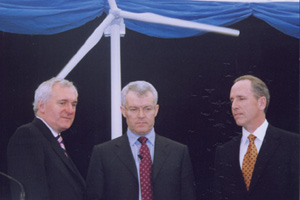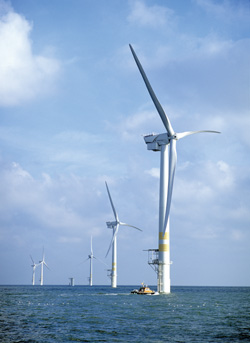
 GE
WIND INAUGURATES ARKLOW
GE
WIND INAUGURATES ARKLOW
(L)
Taoiseach Bertie Ahearn (Irish Prime Minister), Dan O'Connor, GE Country Manager
for Ireland, and Mark Little, Vice President, GE Energy click on the ceremonial
switch to start the seven, GE 3.6 megawatt wind turbines for Arklow's Phase One
on May 26, 2005. The Arklow Wind Park is the world's first offshore wind project
to use turbines over three megawatts and is Ireland's first offshore wind project.
By
Dick Flanagan
Photo by World-Generation
ARKLOW, IR-- GE Energy's Arklow site is the first large scale, offshore wind energy facility developed solely as a technology demonstration platform for offshore wind power. "Wind power is a renewable technology that has moved center stage," said Mark Little, vice president, power generation for GE Energy. The Arklow Bank was chosen because wind speed testing proved it to be one of the windiest found in Europe. The Arklow project also provided a learning base for offshore safety practices. "Safety has been a hallmark of the Arklow project, with no health or safety incidents or injuries recorded since construction started," Little added. Placed in operation in June of 2004, GE's 3.6-megawatt wind turbine exceeded its expected power curve, and exceeded its availability targets. Power curve measures the output of a turbine at varying wind speeds and availability tests the turbine's ability to produce power. Phase OneDeveloped by GE Energy and Airtricity, Ireland's largest renewable energy company, the Arklow Wind Park was introduced by Airtricity as a 520-megawatt project, and is the largest offshore wind park to attain preliminary planning approval through a Foreshore Lease granted by the Irish government in January 2002. Eddie O'Connor, CEO of Airtricity, said: "The success of Phase One has proven the technical capability of this venture and we are very excited about the prospect of harnessing the full potential of this 520-megawatt project. The benefits to our economy and to our environment from offshore wind energy are enormous and subject to the necessary support from our government, similar to that in other EU states. Airtricity is committed to delivering these benefits on a much larger scale." Phase Two The current 25-megawatt project is Phase One of the project. Zeusford, a company owned 50% by Airtricity and EHN of Spain, holds an option to purchase the project from GE. EHN?is an ACCIONA?Group company and has installed 2,518 megawatts of wind in six countries. Further development of the project to its potential 520 megawatts has been proposed by Zeusford. The 520-megawatt project could meet approximately ten percent of Ireland's total electricity needs. The first commercial prototype 3.6-megawatt wind turbine was unveiled by GE during 2002. Installed on land as a test bed, this machine is currently producing power for the Spanish energy supplier Iberdrola. Community ParticipationThe seaside community of Arklow warmly embraced the wind park project, not only for its environmental benefits but also for its economic boon for the County Wicklow. Pat Sweeney, outgoing mayor of Arklow said: "The park had a positive spin-off--hotels, transportation companies, marine and port firms--benefited from new employment and higher revenues." GE is using Arklow's port for O&M activities and equipment staging and storage. After the inaugural ceremonies and lunch, over 200 boarded the vessel, "Ceol na Farraigo" for the six mile voyage for an up-close viewing of the operating turbines. The Arklow Bank in the Irish Sea is a 15-mile long, half-mile wide sand-bank. The first structure of the sectional steel tower is the monopile which is the turbine's foundation. It is hydraulically hammered into the sand-bank and emerges a few meters above the water level. This installation is also widely used for offshore oil and gas rigs. Transitional pieces are mounted on the monopile to provide cable access to the tower. Each wind turbine has a footprint of 16 feet in diameter and are spaced 1,970 feet apart. Turbines reach 406 feet to blade tip and weigh 290 tons. Wind turbines start operating at wind inflow of 4-5 meters per second (ms) and max-out at 12-14 ms. The nacelle housing the transmission equipment is located at the top of the tower. The power generated from the turbines is fed into a 15 km sub-sea cable to a 5 km underground land cable to the local ESB substation for routing to the grid. ESB is Ireland's largest utility with installed capacity of over 4,700 megawatts and serves nearly 2 million customers. GE has worldwide orders for 2,400 megawatts of new wind turbines committed in 2005. GE has installed more than 7,100 wind turbines with a rated capacity of 5,600 megawatts, Manufacturing and assembly facilities are located in Germany, Spain, and the United States. GE in IrelandCurrently, Ireland is ninety percent dependent on imported fuels. GE employs more than 2,200 people across 19 businesses located throughout Ireland, contributing more than 120 million euros to the Irish economy, Dan O'Connor, GE's country manager for Ireland told World-Generation at the press conference.
| ||
| Features |
 What's
Up Wind?
What's
Up Wind?